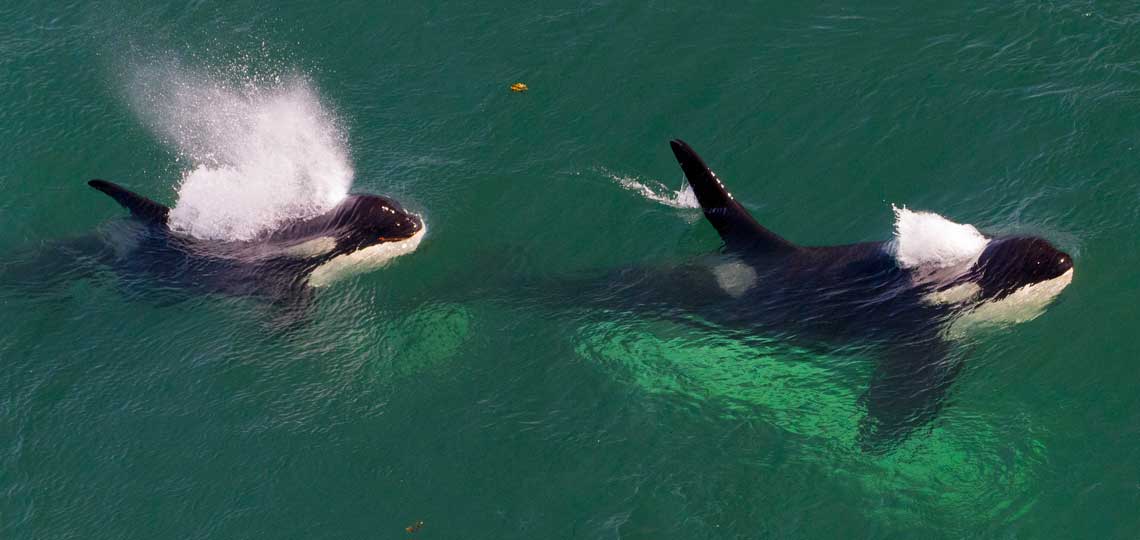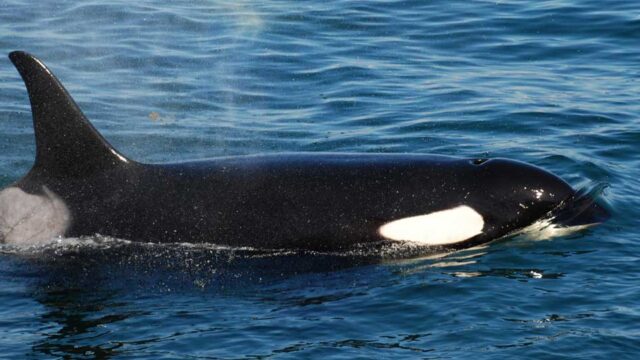Why we are calling for government regulations on the industry. Plus, tips for how to responsibly spot Southern Resident orcas on The Whale Trail:
Killer whales are a captivating species.
The spectacle of an orca’s full breach, or “big splash,” is one of nature’s most incredible displays.
In fact, it thrilled some humans so much that, between 1964 and 1973, the practice of live capturing whales for aquariums led to the loss of nearly 50 Southern Resident killer whales.
Forty-five years later, the Southern Residents have still never fully recovered — and, as the federal government recently acknowledged, the population now faces imminent threats to its survival and recovery.
One of the most pressing threats to the Southern Resident killer whales is disturbance from vessels.
Both the physical presence of boats and the noise they make can interfere with the orcas’ natural behaviors. Research shows that the noise from vessels can hinder Southern Residents’ ability to communicate and find food, and the physical presence of boats can deter them from foraging.
Massive tankers are an obvious source of this problem, which makes the government’s decision to declare threats to the whales imminent one day and then purchase a risky pipeline project less than a week later especially vexing.
Last fall, Ecojustice lawyers argued that the Trans Mountain pipeline project would pose unacceptable risks to the Southern Resident killer whales by increasing tanker traffic seven-fold. But even boats as small as kayaks can impact this endangered population.
Some of the worst offenders are boaters who pursue the orcas for recreational or commercial whale watching.
Though some operators, such as the Pacific Whale Watch Association, have taken voluntary steps to reduce their impact, Canada does not have laws that dictate how close boats can come to whales.
In October, 2017, Minister of Fisheries and Oceans Dominic LeBlanc promised new regulations that would prevent boats from coming within 200 metres of the Southern Residents. But despite setting a spring 2018 target, those rules have yet to materialize.
In contrast to this, Washington State requires whale watching boats to stay 200 yards, or about 183 metres, from orcas.
Establishing foraging refuges
Fortunately, the Canadian government has another opportunity to introduce regulations on whale watching.
On May 24, the same day Minister LeBlanc and Minister of Environment and Climate Change Catherine McKenna announced that the whales face an imminent threat, the ministers also declared fisheries closures in key Southern Resident foraging areas. The closures, which apply to recreational finfish and commercial salmon fisheries in parts of the Salish Sea, came into effect on June 1.
This move addresses another critical threat to the Southern Residents: declining stocks of Chinook salmon, the population’s primary prey. But it does not prevent other boats from entering these areas and disrupting the whales while they forage and feed.
Even if we can ensure more Chinook are available, the whales need to be able to effectively hunt for them.
That is why, together with David Suzuki Foundation, Georgia Strait Association, Natural Resources Defense Council, Raincoast Conservation Foundation and World Wildlife Fund Canada, Ecojustice is asking the government to introduce whale watching restrictions in the same foraging areas where fishery restrictions are now in place.
We are also asking for fishery closures and whale watching restrictions in areas beyond the current zones.
We sent Minister LeBlanc and Minister McKenna a detailed map of proposed “foraging refuges” — places where we think salmon fishing and whale watching should be restricted in order to protect the Southern Residents — in January.
We also sent a petition to the ministers at that time, calling for them to recommend an emergency order to protect the whales under the Species at Risk Act. Emergency orders are a little-used tool that gives the government the power to take wide-ranging actions to protect a species.
Now that the ministers have officially acknowledged that threats to the Southern Residents are imminent, they are required by law to make an emergency order recommendation.
A guide to responsible whale watching
In the 1960s and 1970s human fascination with whales decimated this population, but there are ways for us to admire this incredible species in a responsible way.
For those who want to spot the Southern Residents but do not want to join what some have called the whale-watching “Wild West,” there is an alternative.
The Whale Trail is a network of more than 50 sites up and down the Pacific coast of the United States and Canada where visitors are likely to observe whales — including the Southern Residents.
In British Columbia, the project partners with the BC Cetacean Sightings Network. The network tracks cetacean and sea turtle sightings and uses the information “to aid in future recovery and management plans for species at risk.”
“The single easiest thing we can do to help [the Southern Residents] recover is to turn down the volume in the Salish Sea,” Donna Sandstrom, founder and executive director of The Whale Trail program, said in a phone conversation. “Whale watching from shore is not only fun, it’s a strategic act of conservation.”
While Sandstrom believes there is a place for “sustainable” whale watching from boats, she said that watching from land is the best way to ensure zero impact on the whales.
She also shared a number of tips for where and how to spot Southern Residents in the Salish Sea:
Go here: There are a number of great whale watching sites in British Columbia, Sandstrom says, including on the Southern Gulf Islands in and around Active Pass, and even in West Vancouver. However, her number one recommendation is East Point on Saturna Island. “That’s a hard one to top,” she said.
At this time: Sandstrom said the summer months are the best time to see Southern Residents in the Salish Sea — but be prepared to be patient.
“Whales don’t sleep the same way that humans do. They’re conscious breathers. Their cycles of active and resting are much shorter so there’s no predictable time to say when they’re going to be doing something,” Sandstrom said. “All we can say is generally this is the time of year that they’re going to be there.”
Bring: Sandstrom recommends bringing a pair of waterproof binoculars, in case of rain, and a picnic.
“Wherever you’re going, bring a book or a lunch and something to drink and be prepared to spend a little while. You might get lucky and see the whales when you first get out there, but in the worst case you’re going to have a wonderful afternoon in a beautiful place.”
Look for: “The best way to find the whales is to get some binoculars and what you’re going to want to do is scan the surface of the water and see if you see a spout or a disturbance in the water. Or a big splash! Sometimes you’ll see the end of a breach.”
Photo of Southern Resident killer whales from East Point, Saturna Island, by Miles Ritter, via Flickr. Image obtained under Creative Commons.



